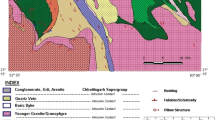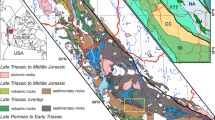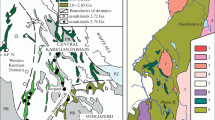Abstract
New geochemical data are presented for a suite of tonalites, granodiorites, trondhjemites and granites intrusive into depleted mantle harzburgites of the Oman–UAE ophiolite. A detailed field, petrological and geochemical examination suggests that these ‘mantle granitoids’ are the product of three processes: (a) the mixing of melts derived from both mafic and metasedimentary sources, (b) interaction with the mantle harzburgite host and (c) the fractional crystallisation of plagioclase, hornblende ± accessory phases. Geochemical data are used to characterise the identity of the protolith(s) by first screening the data for those samples which have experienced fractional crystallisation during emplacement. The resultant ‘reduced’ data set has moderately fractionated REE, with small negative Eu anomalies and fractionated primitive mantle-normalised trace element patterns with high concentrations of fluid mobile elements and lower concentrations of HFS elements and with positive peaks for Rb and Pb and negative troughs for Ba, Nb, Sr and Ti. The character of the protolith was quantified using a melting model based upon a MORB-type basalt similar in composition to the Oman Geotimes lavas and a model using the MUQ (MUd from Queensland) global sediment composition (Kamber et al. Geochim Cosmochim Acta 69:1041–1058, 2005) both with an amphibolite/granulite facies mineralogy. The two compositions bracket the mantle granitoid data set with partial melts of the MORB source yielding trace element compositions lower than the granitoids, whereas melts of the MUQ source yield melts with compositions higher than the granitoids. Mixing of the calculated melt compositions indicates that the measured granitoid compositions represent between 10 and 30 % mixing of a metasedimentary melt into the melt of a mafic source. Current petrological, structural and geochronological data suggest a model for the origin of the Oman ophiolite in which it is formed by spreading above a subduction zone. The results of this study support this model in three ways: (a) trace element data show that the granitoids have interacted with the mantle, implying that they originated below the mantle section of the ophiolite and were emplaced into the mantle wedge from below; (b) a most probable setting for the melting of a sediment–basalt mix is in the upper part of a subducting slab; (c) the high temperature/shallow melting of the sediment and basaltic slab mix can only have been driven by the high temperatures of the overlying mantle wedge; this is most likely during subduction initiation. Thus, sediment melting during subduction initiation represents an important means of refertilising what is otherwise highly depleted mantle.









Similar content being viewed by others
References
Amri I, Benoit M, Ceuleneer G (1996) Tectonic setting for the genesis of oceanic plagiogranites: evidence from a palaeo-spreading structure in the Oman ophiolite. Earth Planet Sci Lett 139:177–194
Barker F (ed) (1979) Trondhjemite: definition, environment and hypotheses of origin. In: Trondhjemites, dacites and related rocks. Elsevier, Amsterdam, pp 1–12
Bea F, Pereira MD, Stroh A (1994) Mineral/leucosome trace-element partitioning in a peraluminous migmatite (a laser ablation-ICP-MS study). Chem Geol 117:291–312. doi:10.1016/0009-2541(94)90133-3
Bhen MD, Kelemen PB, Hirth G, Hacker BR, Massonne H-J (2011) Diapirs as the source of the sediment signature in arc lavas. Nat Geosci 4:641–646
Blundy JD, Wood BJ (1991) Crystal-chemical controls on the partitioning of Sr and Ba between plagioclase feldspar, silicate melts and hydrothermal solutions. Geochim Cosmochim Acta 55:193–200
Bouilhol P, Magni V, van Hunen J, Kaislaniemi L (2015) A numerical approach to melting in warm subduction zones. Earth Planet Sci Lett 411:37–44
Briqueu L, Mevel C, Boudier F (1991) Sr, Nd and Pb isotopic constraints in the genesis of a calc-alkaline plutonic suite in the Oman ophiolite related to the obduction process. In: Peters T, Nicolas A, Coleman RG (eds) Ophiolitic genesis and evolution of the oceanic lithosphere. Kluwer, Dordrecht, pp 517–542
Cawood PA, Hawkesworth CJ, Dhuime B (2013) The continental record and the generation of continental crust. Bull Geol Soc Am 125:14–32
Cowan RJ, Searle MP, Waters DJ (2014) Structure of the metamorphic sole to the Oman ophiolite, Sumeini window and Wadi Tayyin: implications for ophiolite obduction processes. In: Rollinson HR, Searle M, Abassi I, Al-Lazki A, Al-Kindi, M (eds) Tectonic evolution of the Oman mountains. Spec Publ Geol Soc Lond. 392:155–175
Cox J, Searle M, Pederson R (1999) The petrogenesis of leucocratic dykes intruding the northern Semail ophiolite, United Arab Emirates: field relationships, geochemistry and Sr/Nd isotope systematics. Contrib Mineral Petrol 137:267–287
Frost BR, Barnes CG, Collins WJ, Arculus RJ, Ellis DJ, Frost CD (2001) A geochemical classification for granitic rocks. J Petrol 42:2033–2048
Godard M, Bosch D, Einaudi F (2006) A MORB source for low-Ti magmatism in the Semail ophiolite. Chem Geol 234:58–78
Guo Z, Wilson M (2012) The Himalayan leucogranites: constraints on the nature of their crustal source region and geodynamic setting. Gondwana Res 22:300–376
Haase KM, Freund S, Koepke J, Hauff F, Erdmann M (2015) Melts of sediments in the mantle wedge of the Oman ophiolite. Geology 43:275–278. doi:10.1130/G36451.1
Hacker BR, Mosenfelder JL (1996) Metamorphism and deformation along the emplacement thrust of the Samail ophiolite, Oman. Earth Planet Sci Lett 144:435–451
Hall CE, Gurnis M, Sdrolias M, Lavier LL, Muller RD (2003) Catastrophic initiation of subduction following forced convergence across fracture zones. Earth Planet Sci Lett 212:15–30
Inger S, Harris N (1993) Geochemical constraints on leucogranite magmatism in the Langtang Valley, Nepal Himalaya. J Petrol 34:345–368
Ishikawa T, Fujisawa S, Nagaishi K, Masuda T (2005) Trace element characteristics of the fluid liberated from amphibolites-facies slab: inference from the metamorphic sole beneath the Oman ophiolite and implication for boninite genesis. Earth Planet Sci Lett 240:355–377
Kamber BS, Greig A, Collerson KD (2005) A new estimate for the composition of weathered young upper continental crust from alluvial sediments. Geochim Cosmochim Acta 69:1041–1058
Koepke J, Feig ST, Snow J, Freise M (2004) Petrogenesis of oceanic plagiogranites by partial melting of gabbros: an experimental study. Contrib Mineral Petrol 146:414–432
Koepke J, Feig ST, Snow J (2005) Hydrous partial melting within the lower oceanic crust. Terra Nova 16:286–291
Kusano Y, Hayashi M, Adachi Y, Umino S, Miyashita S (2014) Evolution of volcanism and magmatism during initial arc stage: constraints on the tectonic setting of the Oman ophiolite. In: Rollinson HR, Searle M, Abassi I, Al-Lazki A, Al-Kindi M (eds) Tectonic evolution of the Oman mountains. Spec Publ Geol Soc Lond 392:177–193
Lippard SJ, Shelton AW, Gass IG (1986) The ophiolite of northern Oman. Geol Soc Lond Mem 11:178
MacLeod CJ, Lissenberg CJ, Bibby LE (2013) ‘Moist MORB’ axial magmatism in the Oman ophiolite: the evidence against a mid ocean ridge origin. Geology. doi:10.1130/G33904.1
Mallik A, Nelson J, Dasgupta R (2015) Partial melting of fertile peridotite fluxed by hydrous rhyolitic melt at 2–3 GPa: implications for mantle wedge hybridization by sediment melt and generation of ultrapotassic magmas in convergent margins. Contrib Mineral Petrol 169:48. doi:10.1007/s00410-015-1139-2
Mann U, Schmidt MW (2015) Melting of pelitic sediments at sub-arc depths: 1. Flux vs. fluid-absent melting and a parameterisation of melt productivity. Chem Geol 404:150–167
Moyen J-F, Stevens G (2006) Experimental constraints on TTG petrogenesis: implications for Archaean geodynamics. In: Benn K, Mareschal J-C, Condie K (eds) Archaean geodynamics and environments. AGU Monograph 164:149–175
Nash WP, Crecraft HR (1985) Partition coefficients for trace elements in silicic magmas. Geochim Cosmochim Acta 49:2309–2322
Patino-Douce AE (1999) What do experiments tell us about the relative contributions of crust and mantle to the origin of granitic magmas? In: Castro A, Fernandez C, Vigneresse JL (eds) Understanding granites: Integrating new and classical techniques. Spec Publ Geol Soc 168:55–75
Pearce JA, Alabaster T, Shelton AW, Searle MP (1981) The Oman Ophiolite as a Cretaceous arc-basin complex: evidence and implications. Phil Trans R Soc A 300:299–317
Peters T, Kamber BS (1994) Peraluminous potassium-rich granitoids in the Semail ophiolite. Contrib Mineral Petrol 118:229–238
Plank T (2005) Constraints from thorium/lanthanum on sediment recycling at subduction zones and the evolution of the continents. J Petrol 46:921–944
Plank T, Langmuir C (1998) The chemical composition of subducting sediment and its consequences for the crust and mantle. Chem Geol 145:325–394
Rapp RP, Irifune T, Shimizu N, Nishiyama N, Norman MD, Inoue T (2008) Subduction recycling of continental sediments and the origin of geochemically enriched reservoirs in the deep mantle. Earth Planet Sci Lett 271:14–23
Rapp RP, Norman MD, Laporte D, Yaxley GM, Martin H, Foley SF (2010) Continent formation in the Archaean and chemical evolution of the cratonic lithosphere: melt-rock reaction experiments at 3–4 GPa and petrogenesis of Archaean Mg-diorites (sanukitoids). J Petrol 51:1237–1266
Rioux M, Bowring S, Kelemen P, Gordon S, Miller R, Dudas F (2013) Tectonic development of the Samail ophiolite: high precision U-Pb zircon geochronology and Sm-Nd isotopic constraints on crustal growth and emplacement. J Geophys Res Solid Earth 118:1–17. doi:10.1002/jgrb.50139
Rioux M, Garber J, Kelemen P, Searle M, Miyashita S, Adachi Y (2014) The development of subduction below the Oman UAE ophiolite: detailed temporal constraints from high precision U–Pb zircon geochronology. American Geophysical Union Abstracts V51F-03
Robinson PT, Trumbull RB, Schmitt A, Yang J-S, Li J-W, Zhou M-F, Erzinger J, Dare S, Xiong F (2015) The origin and significance of crustal minerals in ophiolitic chromitites and peridotites. Gondwana Res 27:486–506
Rollinson HR (1993) Using Geochemical data: evaluation, presentation, interpretation. Longman, London
Rollinson HR (2009) New models for the genesis of plagiogranites in the Oman ophiolite. Lithos 112:603–614
Rollinson HR (2012) Geochemical constraints on the composition of Archaean lower continental crust: partial melting in the Lewisian granulites. Earth Planet Sci Lett 351–352:1–12
Rollinson HR (2014) Plagiogranites from the mantle section of the Oman ophiolite: models for early crustal evolution. In: Rollinson HR, Searle M, Abassi I, Al-Lazki A, Al-Kindi M (eds) Tectonic evolution of the Oman Mountains. Spec Publ Geol Soc Lond 392:247–261
Rollinson HR, Adetunji J (2013) Mantle podiform chromitites do not form beneath ocean ridges: a case study from the Moho transition zone of the Oman ophiolite. Lithos 177:314–327. doi:10.1016/j.lithos.2013.07.004
Schmidt MW (2015) Melting of pelitic sediments at sub-arc depths: 2. Melt chemistry, viscosities and a parameterisation of melt composition. Chem Geol 404:168–182
Scholl DW, von Heune R (2009) Implications of estimated magmatic additions and recycling losses at the subduction zones of accretionary (non-collisional) and collisional (suturing) orogens. In: Cawood PA, Kroner A (eds) Earth accretionary systems in space and time. Geol Soc Lond Spec Publ 318:105–125
Searle M, Cox J (1999) Tectonic setting, origin and obduction of the Oman ophiolite. Bull Geol Soc Am 111:104–122
Searle M, Cox J (2002) Subduction zone metamorphism during formation and emplacement of the Semail ophiolite in the Oman mountains. Geol Mag 139:241–255
Searle M, Malpas J (1980) Structure and metamorphism of rocks beneath the Semail ophiolite of Oman and their significance in ophiolite obduction. Trans R Soc Edinb Earth Sci 71:247–262
Searle M, Malpas J (1982) Petrochemistry and origin of sub-ophiolitic metamorphic and related rocks in the Oman mountains. J Geol Soc Lond 139:235–248
Searle MP, Cherry AG, Ali MY, Cooper DJW (2014) Tectonics of the Musandam peninsula and northern Oman Mountains: from obduction to continental collision. GeoArabia 19:135–174
Sen C, Dunn T (1994) Experimental modal metasomatism of a spinel lherzolite and the production of amphibole-bearing peridotite. Contrib Mineral Petrol 119:422–432
Stakes DS, Taylor HP (2003) Oxygen isotope and chemical studies on the origin of large plagiogranite bodies in northern Oman, and their relationship to the overlying massive sulphide deposits In: Dilek Y, Robinson PT (eds) Ophiolites in Earth history. Geol Soc Lond Spec Publ 218:315–351
Styles MT, Ellison RA, Phillips ER, Arkley S, Schofield DI, Thomas RJ, Goodenough KM, Farrant AR, McKervey JA, Crowley QG, Pharoah TC (2006) The geology and geophysics of the United Arab Emirates, vol 2. Geology Ministry of Energy, Abu Dhabi
Warren CJ, Parrish RR, Waters DJ, Searle MP (2005) Dating the geologic history of Oman’s Semail ophiolite: insights from U–Pb geochronology. Contrib Mineral Petrol 150:403–422
White RW, Powell R, Holland TJB (2007) Progress relating to calculation of partial melting equilibria for metapelites. J Metamorph Geol 25:511–527
Acknowledgments
This study was funded by a grant from the National Geographic Northern Explorer fund, Grant #GEFNE64-12. I am grateful to Dr Mohammed Ali of the Petroleum Institute, Abu Dhabi, Colleagues in Earth Sciences at Sultan Qaboos University Oman, and Prof Mike Searle of the University of Oxford for helpful discussions and logistic support in the field. Dr Graham Souch of the electron microscope unit at the University of Derby assisted with the mineral chemistry. Helpful reviews were provided by Mike Searle and Karsten Haase and the editor Prof. Othmar Müntener.
Author information
Authors and Affiliations
Corresponding author
Ethics declarations
The appropriate ethical and professional standards were followed during the conduct of this study and in the preparation of this manuscript. There are no potential conflicts of interest related to this study.
Additional information
Communicated by Chris Ballhaus.
Electronic supplementary material
Below is the link to the electronic supplementary material.
Rights and permissions
About this article
Cite this article
Rollinson, H. Slab and sediment melting during subduction initiation: granitoid dykes from the mantle section of the Oman ophiolite. Contrib Mineral Petrol 170, 32 (2015). https://doi.org/10.1007/s00410-015-1177-9
Received:
Accepted:
Published:
DOI: https://doi.org/10.1007/s00410-015-1177-9




